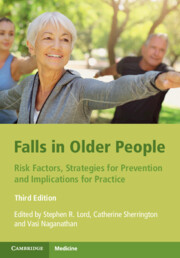Book contents
- Falls in Older People
- Falls in Older People
- Copyright page
- Contents
- Preface
- Contributors
- Part I Epidemiology and Risk Factors for Falls
- Part II Strategies for Prevention
- Part III Implications for Practice
- 28 Strategies to Promote Uptake and Adherence to Fall Prevention Programmes
- 29 Translating Fall Prevention Research into Practice
- 30 Interventions Reduce Falls, but What Is the Cost for Better Health Outcomes?
- 31 Bringing It All Together
- Index
- References
30 - Interventions Reduce Falls, but What Is the Cost for Better Health Outcomes?
from Part III - Implications for Practice
Published online by Cambridge University Press: 04 November 2021
- Falls in Older People
- Falls in Older People
- Copyright page
- Contents
- Preface
- Contributors
- Part I Epidemiology and Risk Factors for Falls
- Part II Strategies for Prevention
- Part III Implications for Practice
- 28 Strategies to Promote Uptake and Adherence to Fall Prevention Programmes
- 29 Translating Fall Prevention Research into Practice
- 30 Interventions Reduce Falls, but What Is the Cost for Better Health Outcomes?
- 31 Bringing It All Together
- Index
- References
Summary
Falls and fall-related injuries among older adults represent a substantial health burden. Approximately 30% of older adults experience at least one fall each year, and half of these individuals fall recurrently [1, 2]. Fall-related non-fatal injuries are associated with increased morbidity, decreased functioning, and increased health care resource utilization [3, 4]. Fall-related injuries such as fracture account for 10-15% of emergency department presentations of those aged 65 years and older [5, 6]. With the number of adults aged 65 and older expected to increase to 1 in 5 by 2050, the economic burden imposed by falls is expected to increase proportionally [7].
- Type
- Chapter
- Information
- Falls in Older PeopleRisk Factors, Strategies for Prevention and Implications for Practice, pp. 460 - 468Publisher: Cambridge University PressPrint publication year: 2021



